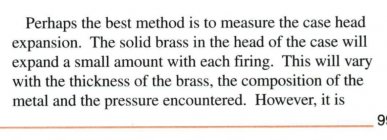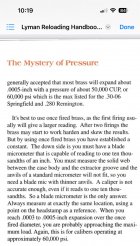wildcatter
Silver $$ Contributor
I read the first 5 pages skimming thru them. First off IO will say EVERYONE should learn to load EVERY rifle as if it were a custom built wildcat!
This makes every rifle perfectly taylored to the bullets it shoots! I have not owned a factory chambered rifle in over 30 years, but the ones I had before that were not always in perfect spec with the generic specs they were supposed to be. But in the past 30 years I have learned the fail safe way to taylor ammo, AS LONG AS THE BARREL IS WHAT IT IS SUPOSED TO BE AS FAR AS THE CALIBER IT IS DESIGNATED AT. Meaning not a .239 6mm bore instead of .243.
I start with a bullet that I seat long and coat the ogive area above and below it with a magic marker, I seat the cartridge under a closed bolt and remove it, with good neck tension you will eject it and see the lands on the bullet, or light neck tension will leave it in the lands. either way you know you have to seat deeper. I will continue to seat .010" deeper ion the case until I have no mark. then I will pull the bullet, and seat a new one back to where the last marks from the rifling were shown. Personally I will start load development there, knowing I am in the lands no more than .010" in the lands.
This lets me back out after I find slight signs of pressure, which are any sign of heavier bolt lift, or once I see any expansion at the base of the cartridge over .001". Then I will note which charge shot the best, but I have found my MAX charge weight for that powder bullet combo.
Once I find what charge shot the best, I use the charge to start loading 3 cases at a time seating .003" farther off the lands and testing that group, then I repeat another .003" further off the lands etc etc untill I am .010" off, seldom I ever and personally I have never found a load the shot better over 10 to 12 thousanths off or in the lands. That is my sweet spot for reloads. especially for Bench rest competition, and yes,, we load HOT!
But you will not find a single top accuracy shooter that does not bump .002" to .003" on their shoulders, they all bump, and they all FL resize. none load by a load manual after starting with their minimum load charge weight. once you get more experienced, you can load powders without having any load data to follow, but understanding burn rates and common sense become mandatory.
As for the cases you have, personally I would pitch them, I would not even allow another shooter to load them, I think they are junk now that they have been loaded improperly enough to have no idea from one to the next what they have been subjected to. The doughnuts are no problem. My K&M neck turner is available with inside neck cutting mandrels I use if I need to remove doughnuts. But some have been over stressed and some stressed, and some subjected to no stress?????
I also would start over now with NEW LAPUA brass, it is the best brass you can buy in every caliber, It is all I use for all my wildcats and sammi cartridges. Alpha may have a few cartridges covered that are as good a cases, but not for 257 Roberts, 270 winchester, etc, that is where I use 8x57 Lapua cases or 30/06 even my 338/06 or a 35 Whelan would use Lapua 30/06 cases necked properly.
Once you do as I said above the only other concern would be neck diameter. That first fired case with a starting load should accept an unfired bullet and fall without help in and back out. Once this is assured, mic the neck for diameter. and record it, then after you resize the case, mic the neck again, and record that, finally load the case and seat your bullet and mic the neck again, I never allow less than .002" neck expansion once I seat the bullet, even a .005" larger neck once seated from the sized nec dimension is acceptable unless it larger than you got when you checked the fired neck diameter.
I am only scratching this subject and not real good and explaining this. But neck size understanding is important, seating depth is NOT COAL! It is ogive to the base of the cartridge is all that matters, the only time COAL matters, is if you are fitting a round to work inside a restricted magazine. bit COAL does not matter as long your cartridge will load the way you want to use it. Ogive to base matters as this is what changes pressure, as well as what is used to tune accuracy with any load.
Never load any bullet deep enough to come in contact with doughnuts in your neck, this is never good! But it easily eliminated!
This makes every rifle perfectly taylored to the bullets it shoots! I have not owned a factory chambered rifle in over 30 years, but the ones I had before that were not always in perfect spec with the generic specs they were supposed to be. But in the past 30 years I have learned the fail safe way to taylor ammo, AS LONG AS THE BARREL IS WHAT IT IS SUPOSED TO BE AS FAR AS THE CALIBER IT IS DESIGNATED AT. Meaning not a .239 6mm bore instead of .243.
I start with a bullet that I seat long and coat the ogive area above and below it with a magic marker, I seat the cartridge under a closed bolt and remove it, with good neck tension you will eject it and see the lands on the bullet, or light neck tension will leave it in the lands. either way you know you have to seat deeper. I will continue to seat .010" deeper ion the case until I have no mark. then I will pull the bullet, and seat a new one back to where the last marks from the rifling were shown. Personally I will start load development there, knowing I am in the lands no more than .010" in the lands.
This lets me back out after I find slight signs of pressure, which are any sign of heavier bolt lift, or once I see any expansion at the base of the cartridge over .001". Then I will note which charge shot the best, but I have found my MAX charge weight for that powder bullet combo.
Once I find what charge shot the best, I use the charge to start loading 3 cases at a time seating .003" farther off the lands and testing that group, then I repeat another .003" further off the lands etc etc untill I am .010" off, seldom I ever and personally I have never found a load the shot better over 10 to 12 thousanths off or in the lands. That is my sweet spot for reloads. especially for Bench rest competition, and yes,, we load HOT!
But you will not find a single top accuracy shooter that does not bump .002" to .003" on their shoulders, they all bump, and they all FL resize. none load by a load manual after starting with their minimum load charge weight. once you get more experienced, you can load powders without having any load data to follow, but understanding burn rates and common sense become mandatory.
As for the cases you have, personally I would pitch them, I would not even allow another shooter to load them, I think they are junk now that they have been loaded improperly enough to have no idea from one to the next what they have been subjected to. The doughnuts are no problem. My K&M neck turner is available with inside neck cutting mandrels I use if I need to remove doughnuts. But some have been over stressed and some stressed, and some subjected to no stress?????
I also would start over now with NEW LAPUA brass, it is the best brass you can buy in every caliber, It is all I use for all my wildcats and sammi cartridges. Alpha may have a few cartridges covered that are as good a cases, but not for 257 Roberts, 270 winchester, etc, that is where I use 8x57 Lapua cases or 30/06 even my 338/06 or a 35 Whelan would use Lapua 30/06 cases necked properly.
Once you do as I said above the only other concern would be neck diameter. That first fired case with a starting load should accept an unfired bullet and fall without help in and back out. Once this is assured, mic the neck for diameter. and record it, then after you resize the case, mic the neck again, and record that, finally load the case and seat your bullet and mic the neck again, I never allow less than .002" neck expansion once I seat the bullet, even a .005" larger neck once seated from the sized nec dimension is acceptable unless it larger than you got when you checked the fired neck diameter.
I am only scratching this subject and not real good and explaining this. But neck size understanding is important, seating depth is NOT COAL! It is ogive to the base of the cartridge is all that matters, the only time COAL matters, is if you are fitting a round to work inside a restricted magazine. bit COAL does not matter as long your cartridge will load the way you want to use it. Ogive to base matters as this is what changes pressure, as well as what is used to tune accuracy with any load.
Never load any bullet deep enough to come in contact with doughnuts in your neck, this is never good! But it easily eliminated!













